 Facebook
Facebook
 X
X
 Instagram
Instagram
 TikTok
TikTok
 Youtube
Youtube
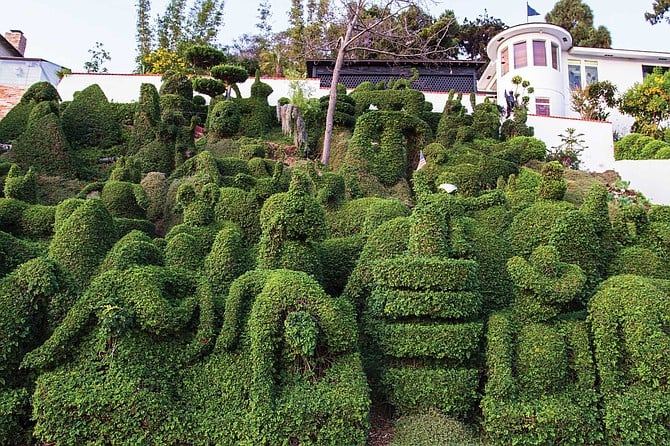
Bushy beasts, a heavenly meal, a giant lemon, a brutal murder, and so much more. Join us for a road trip to see some of San Diego’s more unusual sights.
Roadside attractions have been an integral part of America’s car culture since the first highways were built in the 1920s. Some were established to attract travelers; others just happened to become popular stop-off points because of what occurred there at some time in the past.
Just outside Amarillo, Texas, off Highway 40, is the Cadillac Ranch, a row of vintage Cadillacs stuck headfirst into the ground. The quirky roadside attraction was immortalized by Bruce Springsteen in the 1981 song of the same name.
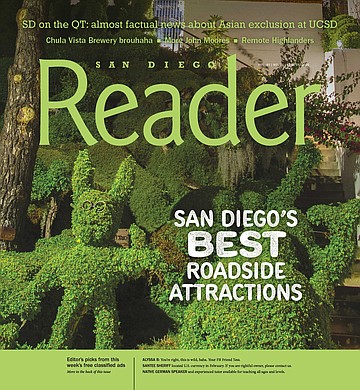
On the main street in Mitchell, South Dakota is the Corn Palace, a Moorish Revival building decorated with murals and designs made from corn and other grains.
A small marker off Highway 154 just south of Gibsland, Louisiana, marks the spot where outlaws Bonnie Parker and Clyde Barrow were shot to death by police on May 23, 1934.
Closer to home, there are the huge concrete-and-steel Cabazon Dinosaurs off the I-10 just before you get to Palm Springs, made famous in the film Pee Wee’s Big Adventure.
The following is a list of 20 roadside attractions right here in San Diego County, ranging from the odd and unusual to the notorious. Most are privately owned and not open to the public, but all are clearly visible from the safety of your car.
The hilly front slope in front of Alex and Edna Harper’s home has for more than 25 years been a living sculpture garden. More than 50 bushes have been meticulously trained, trimmed and shaped to resemble animals, including elephants, monkeys, roosters, and a whale. There’s also a dinosaur, a pyramid, a surfer, and even the gardener who helps the couple create and design their work. New designs frequently appear as the Harpers continue to come up with new additions to what was originally a drab cluster of fast-growing cape honeysuckle plants.
This small community east of Balboa Park is known for its rose-colored sidewalks. They’ve been a hallmark of the community since development began in 1912. Back then, a dull red tint was added to the concrete for the sidewalks in order to give the tract a distinct look. The 40-acre site, originally known as The Tract of Character and now a San Diego Historic District, includes more than 170 “uniquely and architecturally interesting homes,” according to the city planning department. Drive around and you’ll find an eclectic mix of homes built in the Craftsman, Mission Revival, Spanish Colonial Revival, Prairie School, Art Deco, and California Ranch styles.
This quiet residential street in the east San Diego community of Talmadge runs east of Fairmount Avenue and consists mostly of modest little cottages and bungalows, many of them restored or rebuilt. Homes on the west side back up to a canyon that slopes down to Mission Valley. They look like homes in any other gentrified mid-city community, but there’s a Hollywood connection. Talmadge was established in 1925 by Joe Shenick, president of film studio United Artists, and both this street and the community were named after his wife, Norma Talmadge, who was a silent film star — as were her sisters, Natalie and Constance. Norma’s biggest success was 1922’s Smilin’ Through, a melodrama in which she appeared alongside Harrison Ford (the first star with that name) and Wyndham Standing. All three sisters attended a dedication ceremony in Talmadge on January 3, 1926, along with Natalie’s husband, Buster Keaton.
This stately five-bedroom, four-bath mansion, which backs up against Marston Canyon on the northeast end of Balboa Park, is San Diego’s answer to L.A.’s Bundy Street condo where many believe O.J. Simpson brutally killed his ex-wife and a friend. It’s the scene of one of the most notorious murders in San Diego history. On the night of November 5, 1989, socialite Betty Broderick burst into the home her ex-husband Daniel Broderick was sharing with his second wife Linda and shot them both to death with a .38 caliber pistol.
The Broderick Murder House was built in 1935 and was designed by master architect Ralph Frank. Daniel Broderick had purchased the home, which sits on a half-acre lot, in 1986 for about $500,000. After the murders, the home was sold in 1990 for $1,135,000 and again in 1992 for $850,000. It was resold in 2006 for $2,375,000, and again in 2014 for $2,015,000, and in 2018 for $2,225,000.
Kensington is home to hundreds of classic Spanish-style houses, many of them backing up to lush canyons. But this elegant 10-bedroom home comes with a rich religious history. It was built in 1929 for the Watch Tower Bible and Tract Society, the parent organization of the Jehovah’s Witnesses, as a winter home and executive office for Watch Tower president Joseph Franklin Rutherford.
The house was named Beth Sarim, Hebrew for “House of Princes,” in anticipation of the resurrection of such Old Testament prophets as Abraham, Moses, David, and Isaiah, who were expected to be headquartered in San Diego instead of Jerusalem. The deed, written by Rutherford, even states that the property should be held “perpetually in trust” for the Old Testament “princes,” and was to be surrendered to them once they arrived.
Rutherford died in 1942. Abraham, Moses, and their fellow prophets never showed up, and in 1948 the home was sold to a private party.
The Rotating Home of Mount Helix is a pleasant surprise for those venturing up the drive to Mount Helix in the East County community of La Mesa. Perched high up on the northern slope is a circular home, with 5300 square feet of living space, that rotates through 360-degree views of the Coronado Bridge, downtown San Diego, the Pacific coastline north to La Jolla, and the Laguna Mountains.
Al Johnstone and wife Janet completed the home in 2004, spending three years and $1 million to create what they describe on their website as “an example of … Kinetic Architecture... the only structure in the world, that we know of, that is a fully functional rotating structure with all the utilities in the rotating portion.”
The second rotating floor rides on top of a stationary 50-foot-diameter first floor on 40 eight-inch bearings. It is driven by a 1.5 horsepower DC motor and makes one complete rotation in anywhere from 33 minutes to 24 hours. According to the couple’s website, Al designed the house and found or built all the specialty parts required to make the house rotate. Neither Al nor Janet are engineers, so they hired several different engineers to verify and sign off on Al’s work.
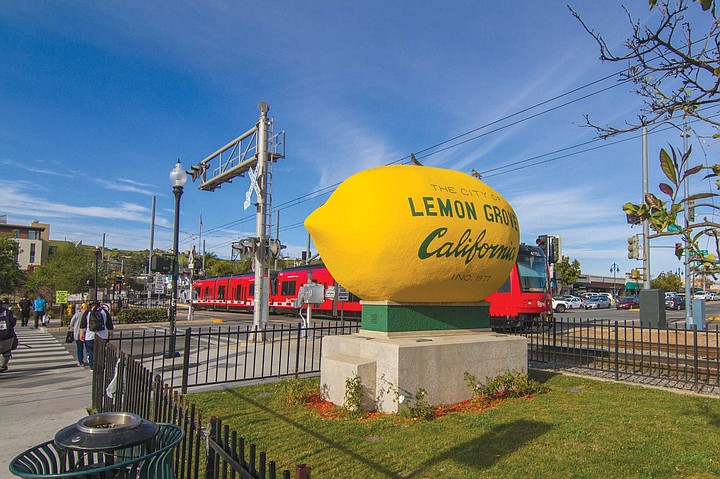
Most cities in San Diego County have artsy signs welcoming visitors to their burg. Lemon Grove has a giant lemon — a 3000-pound salute to the fruit that gave the East County city its name. Measuring about 10 feet long and six feet wide, the lemon — installed next to the trolley tracks — was built as a parade float for the July 4, 1928 Fiesta de San Diego parade. Two years later, the lemon was plastered over to make it more or less permanent and christened as Lemon Grove’s official welcome sign, sitting atop a concrete base engraved with the slogan, “Best Climate on Earth,” which the town adopted back in 1925.
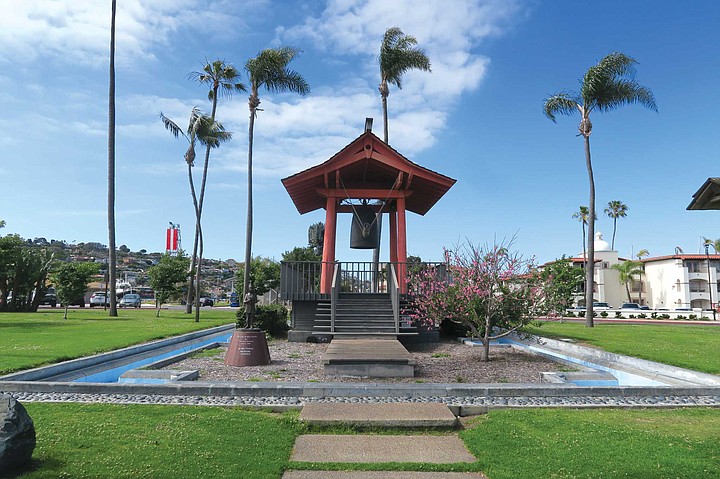
The 1.2-mile drive along the man-made Shelter Island peninsula offers splendid views across the bay to the downtown skyline. It’s also home to an array of public art installations in what’s officially known as Shoreline Park. But the most interesting sight just might be the huge bronze Japanese “friendship” bell at the very end of the drive, where the road loops back. The bell was donated by the city of Yokohama, the first of San Diego’s 16 sister cities, in 1958. It was cast by artist Masahiko Katori, best known for the more than 100 bells he created for Buddhist temples throughout Japan. He cast the famous Hiroshima Peace Bell in September 1964. Katori died in 1988 at the age of 89.
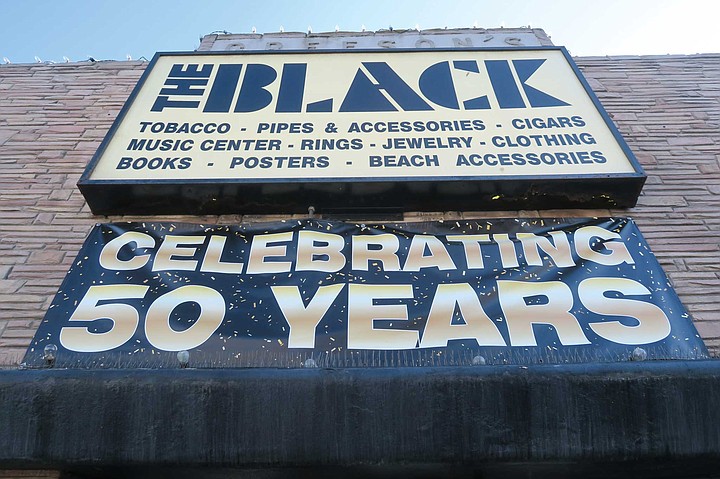
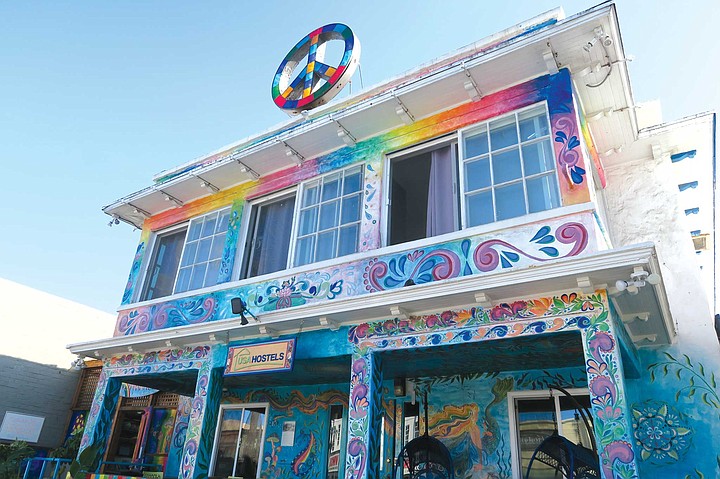
Ocean Beach was San Diego’s answer to San Francisco’s Haight-Ashbury in the 1967 Summer of Love, and just as in the city by the bay, the hippie culture has never really left.
The Black is a 1960s-style “head shop” where you can still buy glass and ceramic pipes, incense, psychedelic art, and even Fabulous Furry Freak Brothers and other underground comics. The Black bills itself as a “smoke shop” and has an assortment of high-end cigars for sale. But don’t be fooled, this place reeks of the 1960s, and we mean that in only the best way.
One block up Newport is the Ocean Beach Youth Hostel. It’s painted in bright colors like something out of a Ken Kesey book. It was built in 1909, after the streetcar line to Ocean Beach was constructed, and from 1914 until its conversion into a youth hostel flourished as the 20-room Newport Hotel. It now has 25 dormitory-style rooms that sleep four to six each.
The duplexes of Clairemont are a throwback to a different time. They’re virtually unchanged from when they were first built in the middle 1950s along Clairemont Drive and Clairemont Mesa Boulevard. Stretching out for several blocks on both streets, they call to mind the classic folk song “Little Boxes,” by Malvina Reynolds. The nondescript cottages, each with about 800 square feet of living space and two garage doors facing the street, are the cornerstone of San Diego’s first suburb and largest post-World War II subdivision. They were built by developer Lou Burgener and Carlos Tavares and named after Tavares’ wife, Claire. Richard Morris, a longtime Clairemont realtor, says the duplexes are “cash cows,” generating as much as $4000 a month in rent. “As soon as one comes on the market, it’s insane how competitive people are on those things,” he says. The typical purchase price is in the mid-$700,000s.
This historic hotel, built in 1920, was ground zero for the biggest and most notorious gun battle in San Diego history. On the afternoon of April 5, 1965, 28-year-old Robert Anderson walked into the Hub Jewelry and Loan Company on the ground floor of the hotel to buy a gun, only to turn it on the credit manager, Louie Richards, who, after being shot, fell just inside the doorway. Another clerk fled into a second-story room and called police. Anderson holed up inside the store and began shooting at police, who shot back. They commandeered a Coca-Cola delivery truck for cover and sent a rescue party to retrieve Richards’ body “while the sound of gunfire rattled and echoed throughout the street,” according to a Channel 8 newscast at the time. Another police officer snuck into the hotel to rescue the clerk and managed to shoot Anderson. By then, a total of 65 police officers had fired more than 1000 bullets. (Anderson was convicted and sentenced to death, but in 1972 his death sentence was commuted to life in prison. He was paroled in 1976 and moved to Seattle, where he died in 1999 at the age of 62.)
This elegant mansion, across the street from the ocean just north of the Hotel del Coronado, was built for San Diego business titan and sugar king John D. Spreckels, who built the Hotel del and owned vast amounts of downtown property, the two daily newspapers, and the San Diego and Arizona Railway. The original home was built with steel-reinforced concrete construction and initially featured four bedrooms, six baths, and about 6600 square feet of living space.
More than 100 years later, the home — which has since been expanded to nine bedrooms plus a guest house — was the scene of a tragic, fatal accident and a second, mysterious death. In July 2011, then-owner Jonathan Shacknai’s son, six-year-old Max, fell down the stairs and, four days later, died of his injuries. In the meantime, two days before young Max died of brain damage, the wealthy pharmaceutical executive’s girlfriend, Rebecca Zahau, was found nude and hanging by a rope around her neck from a second-story balcony overlooking the interior courtyard. Authorities ruled her death a suicide. Her family disagreed and filed a wrongful death suit. In the civil action, Jonah’s brother, Adam Shacknai, who found Zahau’s body, was found responsible. But the case was dismissed when Zahau’s family reached a settlement with Adam Shacknai’s insurance company.
Jonathan Shacknai sold the home in 2011 for about $9 million to a Utah-based limited liability corporation. It was subsequently listed for sale several times at prices as high as $17.9 million; as of March 2020, the home is being offered as a rental for $80,000 a month.
It’s called Wyndham Garden San Diego these days. But back in January 1988, when this was still a Travelodge, celebrated gonzo journalist Hunter S. Thompson stayed here for three nights while in town for an appearance at Symphony Hall the night before the January 31 Super Bowl between the Washington Redskins and the Denver Broncos.
Thompson didn’t attend the game; he traded his two tickets for an ounce of cocaine and spent most of his stay here inside his second-story suite, drinking and doing drugs. The night after the big game, there was a party in his suite; among the guests were political consultant and pollster Patrick Caddell, one of the architects of George McGovern’s unsuccessful 1972 run for the presidency. Thompson got belligerently drunk and screamed at everyone to leave the room. Thompson would only venture out of his suite to eat at the hotel restaurant, known at the time as Baker’s Square. He caused a fracas when he chased a girl into the kitchen because she rebuffed his advances.
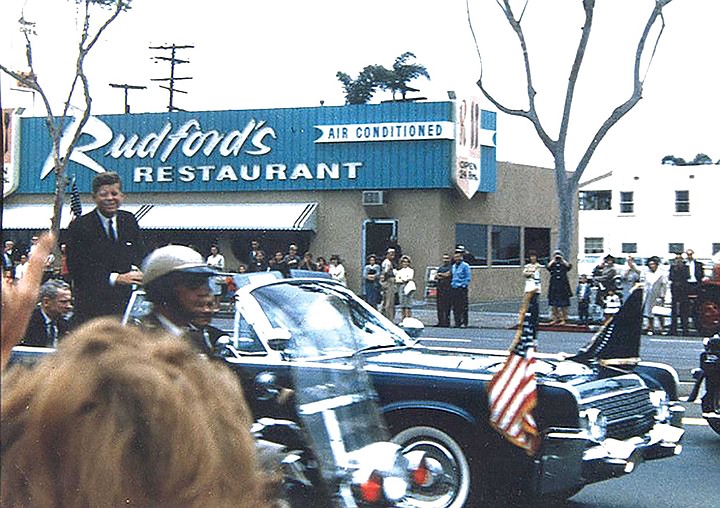
On June 6, 1963, President John F. Kennedy was riding in his black Lincoln bubbletop convertible eastward along El Cajon Boulevard toward San Diego State, where he was to deliver the commencement address. In one of the most famous photos of that day, the President can be seen cruising right past Rudford’s, a classic diner that had been opened in 1949 by John Thomas “Tommy” Rudford. The restaurant remains open to this day and hasn’t changed much in appearance, neither inside nor out. Kennedy, of course, was shot to death less than six months later in Dallas, sitting in the exact same spot in the exact same car.
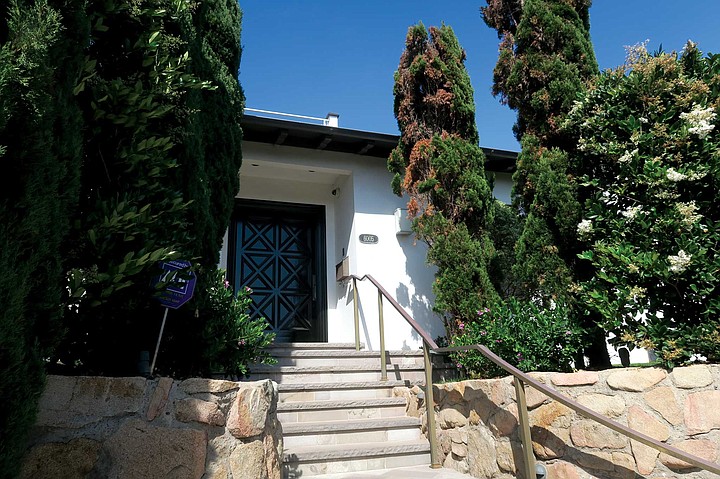
This sprawling mid-century house on a corner lot at the north end of Bird Rock was once the home of famed mystery writer Raymond Chandler, the author of classics Farewell, My Lovely, The Long Goodbye, and The Big Sleep. The last was made into a film noir classic by director Howard Hawks, with Humphrey Bogart in the lead role and a screenplay written by William Faulkner.
Chandler moved into the house in 1946 with his wife, Cissy, 18 years his senior, and their cat, Taki, according to a February 2018 story in the La Jolla Light. After Cissy died in 1954, he remained there until his death in 1959. While in the house — which at the time was a single-story ranch-style home; a second story was added later, in 2007 — he drank heavily, wrote the novels The Little Sister and Playback, and tried to kill himself. According to the La Jolla Light story, on February 22, 1955, Chandler was found in the bathroom of the home, “wrapped in a shower curtain and trying to summon the nerve to insert a gun into his mouth. San Diego Police were notified when the mystery novelist phoned a friend, distraught, saying that he planned to kill himself. Chandler got off one shot, which missed. A second failed to fire just before the officer discovered him.”
But he loved the house, according to the Light, and once called it in a letter “a far better home than any out-of-work pulp writer has any right to expect.”
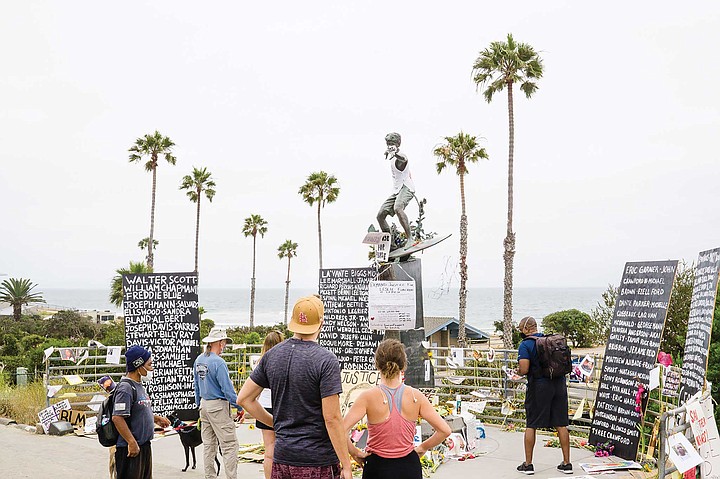
The official name of the six-foot-tall bronze sculpture of a surfer is Magic Carpet Ride. It was commissioned by the Cardiff Botanical Society at a cost of $120,000 and installed in 2007 at the entrance to the San Elijo State Beach campground. The sculpture, mounted on a six-foot-high granite base, was crafted by Matthew Antichevich, an artist and sculpture instructor at Mount San Jacinto College in east L.A. County. Locals soon christened it the Cardiff Kook, “kook” being a pejorative slang name for a beginning surfer, and began decorating it in outlandish manners. The Kook has been dressed up as Santa Claus, Uncle Sam, and a Mexican lucha libre wrestler. Since the pandemic began, the Kook has been wearing a mask.
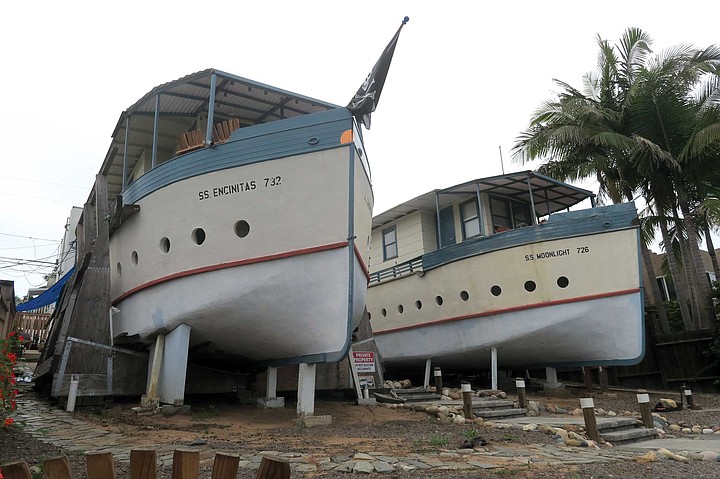
These two homes, built in the shape of boats, occupy two narrow lots near the ocean’s edge in the heart of Encinitas. The SS Moonlight is at 726 Third Street, while the SS Encinitas is next door at 732 Third Street. Both homes were built in 1928 by Miles Kellogg, an architect whose father was a sea captain. He constructed the side-by-side homes “using timber salvaged from the local bathhouse and a hotel that failed to survive Prohibition’s dry years,” according to the Encinitas Historical Association, which acquired them in 2008 for preservation. The Encinitas boat houses are among the first local structures to be built of repurposed materials, and represent what the association calls “early California ‘courtyard architecture’ as well as the kind of vernacular design associated with historic Highway 101.” Each house is 15 feet tall and 20 feet long and consists of about 1100 square feet of living space.
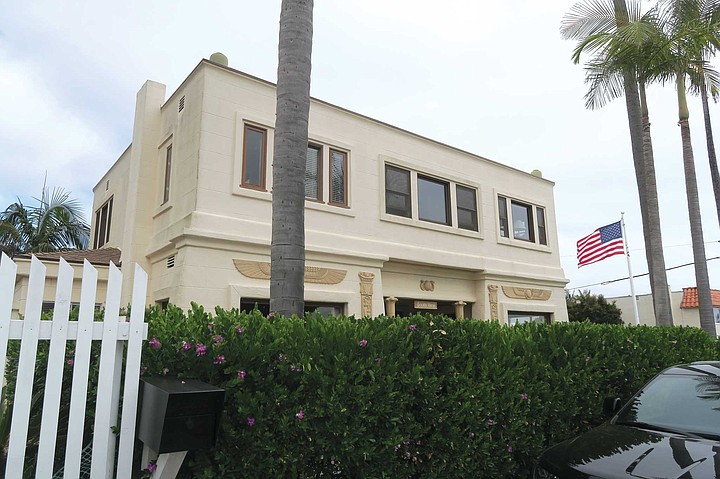
San Diego County is home to several examples of the short-lived Egyptian Revival school of architecture, including several apartments along Park Boulevard. None are as pure and authentic as this stately home in Cardiff. The spark for this unusual architectural style was the hit 1921 movie The Sheik, with Rudolph Valentino, and the discovery a year later of Tutankhamen’s tomb. The unearthing of the final resting place of the boy king by British explorer Howard Carter and his colleagues was a huge media sensation. “The fact that Carter was being assisted by archaeologists and photographers from an American museum, the Metropolitan Museum of Art in New York, added to a sense of national pride and personal involvement with the discovery,” according to the Journal of San Diego History.
This particular house was built in 1923 by land developer and builder O. L. Steel, on a hilltop lot in what he hoped would become a tract of Egyptian-style homes surrounded by avocado groves. The house retains its carefully painted columns, planters, and bas-relief winged suns over the windows and pharaoh heads on the walls by the front porch. Steel later built a second, smaller Egyptian-style home down the hill from the first house, in the 1200 block of San Dieguito Drive.
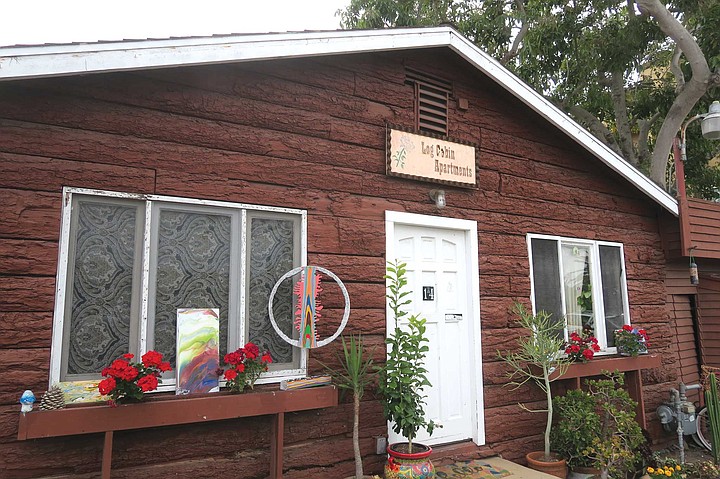
Back when the Coast Highway was the main north-south artery in coastal California, the two-lane road was dotted with auto courts, later known as motels, catering to travelers in search of cheap and easily accessible overnight accommodations for themselves and their cars. This charming little roadside village of 15 red cabins was built in 1935, when Highway 101 was the only way to get from Los Angeles to the Del Mar racetrack, San Diego, and Tijuana. Famous overnight guests reportedly included a honeymooning Desi Arnaz and Lucille Ball as well as Sammy Davis, Jr. and his dad, who lived in Cabin No. 5 during the Del Mar racing season in the 1960s. The cabins were converted into apartments in the 1980s.
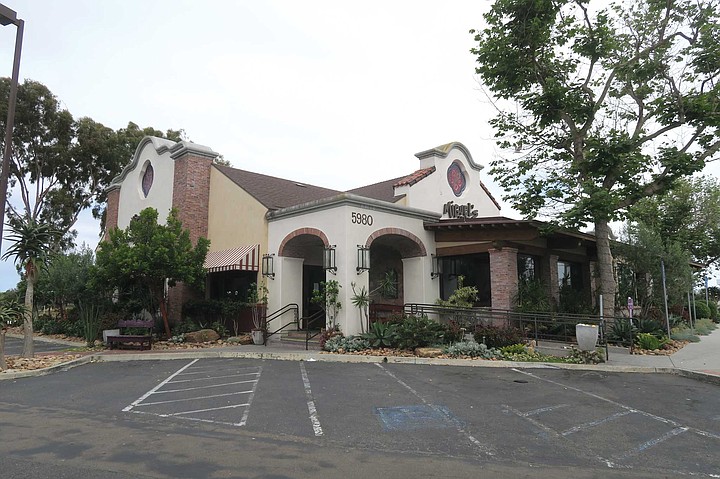
On March 26, 1997, police discovered the bodies of 39 victims of a mass suicide in a Rancho Santa Fe mansion. The 21 women and 18 men had been members of the Heaven’s Gate cult, whose leader, Marshall Applewhite, a former music professor, preached that suicide would allow them to leave their bodily “containers” and enter an alien spacecraft hidden behind the Hale-Bopp comet. In late March 1997, as Hale-Bopp reached its closest distance to Earth, Applewhite and 38 of his followers drank a lethal mixture of phenobarbital and vodka and lay down to die, believing they were on their way to a higher existence.
Before they died, they gathered at this restaurant — at the time, a Marie Callendar’s — for a final meal together, according to the book Weird California. On the menu: iced tea, turkey pot pie, and salad, with blueberry cheesecake for dessert.


Bushy beasts, a heavenly meal, a giant lemon, a brutal murder, and so much more. Join us for a road trip to see some of San Diego’s more unusual sights.
Roadside attractions have been an integral part of America’s car culture since the first highways were built in the 1920s. Some were established to attract travelers; others just happened to become popular stop-off points because of what occurred there at some time in the past.
Just outside Amarillo, Texas, off Highway 40, is the Cadillac Ranch, a row of vintage Cadillacs stuck headfirst into the ground. The quirky roadside attraction was immortalized by Bruce Springsteen in the 1981 song of the same name.

On the main street in Mitchell, South Dakota is the Corn Palace, a Moorish Revival building decorated with murals and designs made from corn and other grains.
A small marker off Highway 154 just south of Gibsland, Louisiana, marks the spot where outlaws Bonnie Parker and Clyde Barrow were shot to death by police on May 23, 1934.
Closer to home, there are the huge concrete-and-steel Cabazon Dinosaurs off the I-10 just before you get to Palm Springs, made famous in the film Pee Wee’s Big Adventure.
The following is a list of 20 roadside attractions right here in San Diego County, ranging from the odd and unusual to the notorious. Most are privately owned and not open to the public, but all are clearly visible from the safety of your car.
The hilly front slope in front of Alex and Edna Harper’s home has for more than 25 years been a living sculpture garden. More than 50 bushes have been meticulously trained, trimmed and shaped to resemble animals, including elephants, monkeys, roosters, and a whale. There’s also a dinosaur, a pyramid, a surfer, and even the gardener who helps the couple create and design their work. New designs frequently appear as the Harpers continue to come up with new additions to what was originally a drab cluster of fast-growing cape honeysuckle plants.
This small community east of Balboa Park is known for its rose-colored sidewalks. They’ve been a hallmark of the community since development began in 1912. Back then, a dull red tint was added to the concrete for the sidewalks in order to give the tract a distinct look. The 40-acre site, originally known as The Tract of Character and now a San Diego Historic District, includes more than 170 “uniquely and architecturally interesting homes,” according to the city planning department. Drive around and you’ll find an eclectic mix of homes built in the Craftsman, Mission Revival, Spanish Colonial Revival, Prairie School, Art Deco, and California Ranch styles.
This quiet residential street in the east San Diego community of Talmadge runs east of Fairmount Avenue and consists mostly of modest little cottages and bungalows, many of them restored or rebuilt. Homes on the west side back up to a canyon that slopes down to Mission Valley. They look like homes in any other gentrified mid-city community, but there’s a Hollywood connection. Talmadge was established in 1925 by Joe Shenick, president of film studio United Artists, and both this street and the community were named after his wife, Norma Talmadge, who was a silent film star — as were her sisters, Natalie and Constance. Norma’s biggest success was 1922’s Smilin’ Through, a melodrama in which she appeared alongside Harrison Ford (the first star with that name) and Wyndham Standing. All three sisters attended a dedication ceremony in Talmadge on January 3, 1926, along with Natalie’s husband, Buster Keaton.
This stately five-bedroom, four-bath mansion, which backs up against Marston Canyon on the northeast end of Balboa Park, is San Diego’s answer to L.A.’s Bundy Street condo where many believe O.J. Simpson brutally killed his ex-wife and a friend. It’s the scene of one of the most notorious murders in San Diego history. On the night of November 5, 1989, socialite Betty Broderick burst into the home her ex-husband Daniel Broderick was sharing with his second wife Linda and shot them both to death with a .38 caliber pistol.
The Broderick Murder House was built in 1935 and was designed by master architect Ralph Frank. Daniel Broderick had purchased the home, which sits on a half-acre lot, in 1986 for about $500,000. After the murders, the home was sold in 1990 for $1,135,000 and again in 1992 for $850,000. It was resold in 2006 for $2,375,000, and again in 2014 for $2,015,000, and in 2018 for $2,225,000.
Kensington is home to hundreds of classic Spanish-style houses, many of them backing up to lush canyons. But this elegant 10-bedroom home comes with a rich religious history. It was built in 1929 for the Watch Tower Bible and Tract Society, the parent organization of the Jehovah’s Witnesses, as a winter home and executive office for Watch Tower president Joseph Franklin Rutherford.
The house was named Beth Sarim, Hebrew for “House of Princes,” in anticipation of the resurrection of such Old Testament prophets as Abraham, Moses, David, and Isaiah, who were expected to be headquartered in San Diego instead of Jerusalem. The deed, written by Rutherford, even states that the property should be held “perpetually in trust” for the Old Testament “princes,” and was to be surrendered to them once they arrived.
Rutherford died in 1942. Abraham, Moses, and their fellow prophets never showed up, and in 1948 the home was sold to a private party.
The Rotating Home of Mount Helix is a pleasant surprise for those venturing up the drive to Mount Helix in the East County community of La Mesa. Perched high up on the northern slope is a circular home, with 5300 square feet of living space, that rotates through 360-degree views of the Coronado Bridge, downtown San Diego, the Pacific coastline north to La Jolla, and the Laguna Mountains.
Al Johnstone and wife Janet completed the home in 2004, spending three years and $1 million to create what they describe on their website as “an example of … Kinetic Architecture... the only structure in the world, that we know of, that is a fully functional rotating structure with all the utilities in the rotating portion.”
The second rotating floor rides on top of a stationary 50-foot-diameter first floor on 40 eight-inch bearings. It is driven by a 1.5 horsepower DC motor and makes one complete rotation in anywhere from 33 minutes to 24 hours. According to the couple’s website, Al designed the house and found or built all the specialty parts required to make the house rotate. Neither Al nor Janet are engineers, so they hired several different engineers to verify and sign off on Al’s work.

Most cities in San Diego County have artsy signs welcoming visitors to their burg. Lemon Grove has a giant lemon — a 3000-pound salute to the fruit that gave the East County city its name. Measuring about 10 feet long and six feet wide, the lemon — installed next to the trolley tracks — was built as a parade float for the July 4, 1928 Fiesta de San Diego parade. Two years later, the lemon was plastered over to make it more or less permanent and christened as Lemon Grove’s official welcome sign, sitting atop a concrete base engraved with the slogan, “Best Climate on Earth,” which the town adopted back in 1925.

The 1.2-mile drive along the man-made Shelter Island peninsula offers splendid views across the bay to the downtown skyline. It’s also home to an array of public art installations in what’s officially known as Shoreline Park. But the most interesting sight just might be the huge bronze Japanese “friendship” bell at the very end of the drive, where the road loops back. The bell was donated by the city of Yokohama, the first of San Diego’s 16 sister cities, in 1958. It was cast by artist Masahiko Katori, best known for the more than 100 bells he created for Buddhist temples throughout Japan. He cast the famous Hiroshima Peace Bell in September 1964. Katori died in 1988 at the age of 89.


Ocean Beach was San Diego’s answer to San Francisco’s Haight-Ashbury in the 1967 Summer of Love, and just as in the city by the bay, the hippie culture has never really left.
The Black is a 1960s-style “head shop” where you can still buy glass and ceramic pipes, incense, psychedelic art, and even Fabulous Furry Freak Brothers and other underground comics. The Black bills itself as a “smoke shop” and has an assortment of high-end cigars for sale. But don’t be fooled, this place reeks of the 1960s, and we mean that in only the best way.
One block up Newport is the Ocean Beach Youth Hostel. It’s painted in bright colors like something out of a Ken Kesey book. It was built in 1909, after the streetcar line to Ocean Beach was constructed, and from 1914 until its conversion into a youth hostel flourished as the 20-room Newport Hotel. It now has 25 dormitory-style rooms that sleep four to six each.
The duplexes of Clairemont are a throwback to a different time. They’re virtually unchanged from when they were first built in the middle 1950s along Clairemont Drive and Clairemont Mesa Boulevard. Stretching out for several blocks on both streets, they call to mind the classic folk song “Little Boxes,” by Malvina Reynolds. The nondescript cottages, each with about 800 square feet of living space and two garage doors facing the street, are the cornerstone of San Diego’s first suburb and largest post-World War II subdivision. They were built by developer Lou Burgener and Carlos Tavares and named after Tavares’ wife, Claire. Richard Morris, a longtime Clairemont realtor, says the duplexes are “cash cows,” generating as much as $4000 a month in rent. “As soon as one comes on the market, it’s insane how competitive people are on those things,” he says. The typical purchase price is in the mid-$700,000s.
This historic hotel, built in 1920, was ground zero for the biggest and most notorious gun battle in San Diego history. On the afternoon of April 5, 1965, 28-year-old Robert Anderson walked into the Hub Jewelry and Loan Company on the ground floor of the hotel to buy a gun, only to turn it on the credit manager, Louie Richards, who, after being shot, fell just inside the doorway. Another clerk fled into a second-story room and called police. Anderson holed up inside the store and began shooting at police, who shot back. They commandeered a Coca-Cola delivery truck for cover and sent a rescue party to retrieve Richards’ body “while the sound of gunfire rattled and echoed throughout the street,” according to a Channel 8 newscast at the time. Another police officer snuck into the hotel to rescue the clerk and managed to shoot Anderson. By then, a total of 65 police officers had fired more than 1000 bullets. (Anderson was convicted and sentenced to death, but in 1972 his death sentence was commuted to life in prison. He was paroled in 1976 and moved to Seattle, where he died in 1999 at the age of 62.)
This elegant mansion, across the street from the ocean just north of the Hotel del Coronado, was built for San Diego business titan and sugar king John D. Spreckels, who built the Hotel del and owned vast amounts of downtown property, the two daily newspapers, and the San Diego and Arizona Railway. The original home was built with steel-reinforced concrete construction and initially featured four bedrooms, six baths, and about 6600 square feet of living space.
More than 100 years later, the home — which has since been expanded to nine bedrooms plus a guest house — was the scene of a tragic, fatal accident and a second, mysterious death. In July 2011, then-owner Jonathan Shacknai’s son, six-year-old Max, fell down the stairs and, four days later, died of his injuries. In the meantime, two days before young Max died of brain damage, the wealthy pharmaceutical executive’s girlfriend, Rebecca Zahau, was found nude and hanging by a rope around her neck from a second-story balcony overlooking the interior courtyard. Authorities ruled her death a suicide. Her family disagreed and filed a wrongful death suit. In the civil action, Jonah’s brother, Adam Shacknai, who found Zahau’s body, was found responsible. But the case was dismissed when Zahau’s family reached a settlement with Adam Shacknai’s insurance company.
Jonathan Shacknai sold the home in 2011 for about $9 million to a Utah-based limited liability corporation. It was subsequently listed for sale several times at prices as high as $17.9 million; as of March 2020, the home is being offered as a rental for $80,000 a month.
It’s called Wyndham Garden San Diego these days. But back in January 1988, when this was still a Travelodge, celebrated gonzo journalist Hunter S. Thompson stayed here for three nights while in town for an appearance at Symphony Hall the night before the January 31 Super Bowl between the Washington Redskins and the Denver Broncos.
Thompson didn’t attend the game; he traded his two tickets for an ounce of cocaine and spent most of his stay here inside his second-story suite, drinking and doing drugs. The night after the big game, there was a party in his suite; among the guests were political consultant and pollster Patrick Caddell, one of the architects of George McGovern’s unsuccessful 1972 run for the presidency. Thompson got belligerently drunk and screamed at everyone to leave the room. Thompson would only venture out of his suite to eat at the hotel restaurant, known at the time as Baker’s Square. He caused a fracas when he chased a girl into the kitchen because she rebuffed his advances.

On June 6, 1963, President John F. Kennedy was riding in his black Lincoln bubbletop convertible eastward along El Cajon Boulevard toward San Diego State, where he was to deliver the commencement address. In one of the most famous photos of that day, the President can be seen cruising right past Rudford’s, a classic diner that had been opened in 1949 by John Thomas “Tommy” Rudford. The restaurant remains open to this day and hasn’t changed much in appearance, neither inside nor out. Kennedy, of course, was shot to death less than six months later in Dallas, sitting in the exact same spot in the exact same car.

This sprawling mid-century house on a corner lot at the north end of Bird Rock was once the home of famed mystery writer Raymond Chandler, the author of classics Farewell, My Lovely, The Long Goodbye, and The Big Sleep. The last was made into a film noir classic by director Howard Hawks, with Humphrey Bogart in the lead role and a screenplay written by William Faulkner.
Chandler moved into the house in 1946 with his wife, Cissy, 18 years his senior, and their cat, Taki, according to a February 2018 story in the La Jolla Light. After Cissy died in 1954, he remained there until his death in 1959. While in the house — which at the time was a single-story ranch-style home; a second story was added later, in 2007 — he drank heavily, wrote the novels The Little Sister and Playback, and tried to kill himself. According to the La Jolla Light story, on February 22, 1955, Chandler was found in the bathroom of the home, “wrapped in a shower curtain and trying to summon the nerve to insert a gun into his mouth. San Diego Police were notified when the mystery novelist phoned a friend, distraught, saying that he planned to kill himself. Chandler got off one shot, which missed. A second failed to fire just before the officer discovered him.”
But he loved the house, according to the Light, and once called it in a letter “a far better home than any out-of-work pulp writer has any right to expect.”

The official name of the six-foot-tall bronze sculpture of a surfer is Magic Carpet Ride. It was commissioned by the Cardiff Botanical Society at a cost of $120,000 and installed in 2007 at the entrance to the San Elijo State Beach campground. The sculpture, mounted on a six-foot-high granite base, was crafted by Matthew Antichevich, an artist and sculpture instructor at Mount San Jacinto College in east L.A. County. Locals soon christened it the Cardiff Kook, “kook” being a pejorative slang name for a beginning surfer, and began decorating it in outlandish manners. The Kook has been dressed up as Santa Claus, Uncle Sam, and a Mexican lucha libre wrestler. Since the pandemic began, the Kook has been wearing a mask.

These two homes, built in the shape of boats, occupy two narrow lots near the ocean’s edge in the heart of Encinitas. The SS Moonlight is at 726 Third Street, while the SS Encinitas is next door at 732 Third Street. Both homes were built in 1928 by Miles Kellogg, an architect whose father was a sea captain. He constructed the side-by-side homes “using timber salvaged from the local bathhouse and a hotel that failed to survive Prohibition’s dry years,” according to the Encinitas Historical Association, which acquired them in 2008 for preservation. The Encinitas boat houses are among the first local structures to be built of repurposed materials, and represent what the association calls “early California ‘courtyard architecture’ as well as the kind of vernacular design associated with historic Highway 101.” Each house is 15 feet tall and 20 feet long and consists of about 1100 square feet of living space.

San Diego County is home to several examples of the short-lived Egyptian Revival school of architecture, including several apartments along Park Boulevard. None are as pure and authentic as this stately home in Cardiff. The spark for this unusual architectural style was the hit 1921 movie The Sheik, with Rudolph Valentino, and the discovery a year later of Tutankhamen’s tomb. The unearthing of the final resting place of the boy king by British explorer Howard Carter and his colleagues was a huge media sensation. “The fact that Carter was being assisted by archaeologists and photographers from an American museum, the Metropolitan Museum of Art in New York, added to a sense of national pride and personal involvement with the discovery,” according to the Journal of San Diego History.
This particular house was built in 1923 by land developer and builder O. L. Steel, on a hilltop lot in what he hoped would become a tract of Egyptian-style homes surrounded by avocado groves. The house retains its carefully painted columns, planters, and bas-relief winged suns over the windows and pharaoh heads on the walls by the front porch. Steel later built a second, smaller Egyptian-style home down the hill from the first house, in the 1200 block of San Dieguito Drive.

Back when the Coast Highway was the main north-south artery in coastal California, the two-lane road was dotted with auto courts, later known as motels, catering to travelers in search of cheap and easily accessible overnight accommodations for themselves and their cars. This charming little roadside village of 15 red cabins was built in 1935, when Highway 101 was the only way to get from Los Angeles to the Del Mar racetrack, San Diego, and Tijuana. Famous overnight guests reportedly included a honeymooning Desi Arnaz and Lucille Ball as well as Sammy Davis, Jr. and his dad, who lived in Cabin No. 5 during the Del Mar racing season in the 1960s. The cabins were converted into apartments in the 1980s.

On March 26, 1997, police discovered the bodies of 39 victims of a mass suicide in a Rancho Santa Fe mansion. The 21 women and 18 men had been members of the Heaven’s Gate cult, whose leader, Marshall Applewhite, a former music professor, preached that suicide would allow them to leave their bodily “containers” and enter an alien spacecraft hidden behind the Hale-Bopp comet. In late March 1997, as Hale-Bopp reached its closest distance to Earth, Applewhite and 38 of his followers drank a lethal mixture of phenobarbital and vodka and lay down to die, believing they were on their way to a higher existence.
Before they died, they gathered at this restaurant — at the time, a Marie Callendar’s — for a final meal together, according to the book Weird California. On the menu: iced tea, turkey pot pie, and salad, with blueberry cheesecake for dessert.
Comments